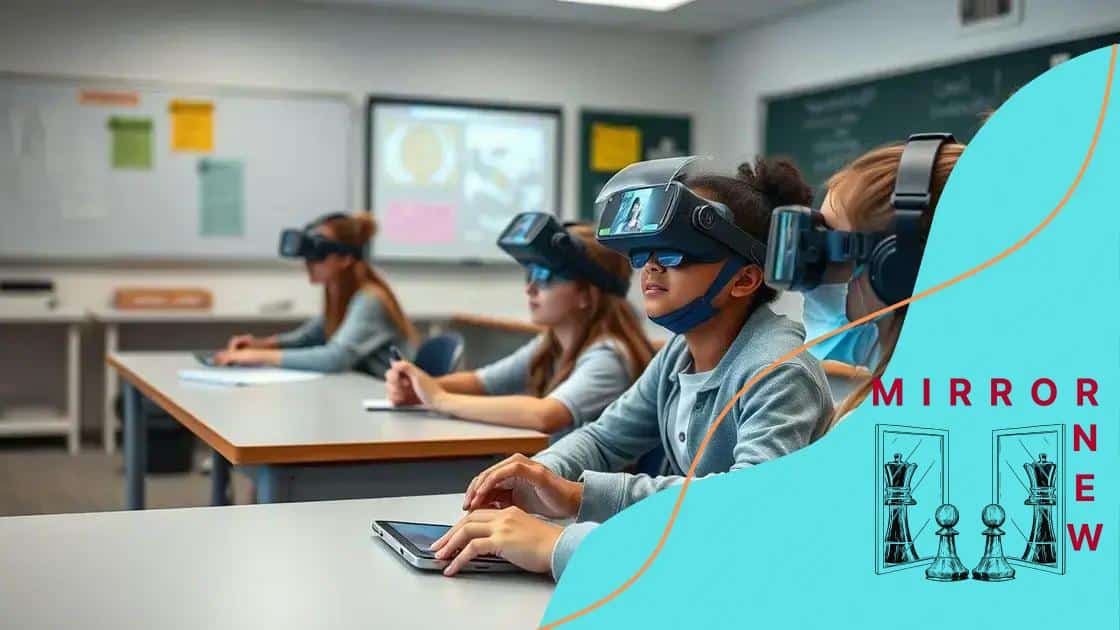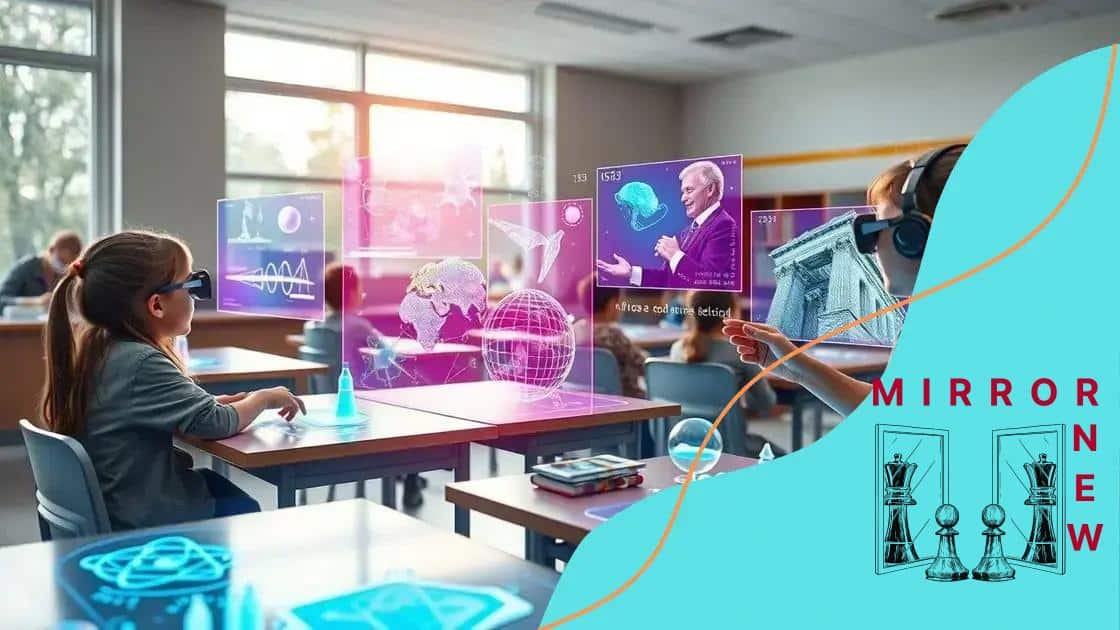How AR is being used for hands-on learning experiences

Augmented Reality (AR) is revolutionizing education by making learning more interactive and engaging, allowing students to visualize complex concepts, explore various subjects, and foster collaboration in the classroom.
How AR is being used for hands-on learning experiences is reshaping traditional education. Imagine learning about ecosystems while being immersed in a virtual rainforest. Curious about how this technology impacts students? Let’s dive in!
Exploring the concept of augmented reality
Exploring the concept of augmented reality can change how we interact with our environment. It blends digital information with the real world, offering immersive experiences for learning and play. Imagine holding a tablet that shows a 3D model of the solar system, where you can interact with planets and stars. This fusion of reality and digital media is what makes augmented reality (AR) so captivating.
What is Augmented Reality?
Augmented reality enhances what we see, hear, and feel. It layers digital content over our physical surroundings, using devices like smartphones and AR glasses. This technology allows users to see and engage with items that aren’t there in reality, creating an interactive experience.
Applications of Augmented Reality
AR is widely used in various fields:
- Education: Students can learn in interactive environments, making complex subjects like biology or physics easier to grasp.
- Healthcare: Medical professionals use AR for simulations and better patient care.
- Retail: Customers can see how products will look in their homes before making a purchase.
- Entertainment: Games like Pokémon GO bring characters to life in real settings.
This technology is not just limited to education or entertainment. It is evolving rapidly, providing innovative solutions across sectors. Developers are constantly finding new ways to integrate AR features, making it more accessible worldwide. By merging the real and virtual, AR enhances our experiences and understanding of different subjects.
In classrooms, students using AR can visualize concepts that are otherwise difficult to comprehend. For instance, when studying anatomy, a student could explore a 3D model of the human body, manipulating parts as they learn. This kind of engagement keeps learners interested and improves retention.
As AR continues to advance, we can expect even more exciting applications that transform how we learn and interact with the world around us.
Benefits of AR in education
The benefits of AR in education are transforming how students learn and engage with new material. By integrating technology in the classroom, teachers can create interactive experiences that make learning more effective and enjoyable.
Enhanced Engagement
One of the greatest advantages of AR is that it captures students’ attention. Students who might struggle with traditional learning methods often find AR experiences intriguing. When lessons come to life through augmented reality, learners become more curious and eager to explore topics further.
Improved Understanding
AR allows students to visualize complex concepts in a hands-on way:
- Interactive models: Students can manipulate 3D models, helping them grasp difficult subjects.
- Real-world applications: AR brings real-world connections to theoretical lessons, making the material relatable.
- Personalized learning: Students can learn at their own pace, catering to diverse learning styles.
This engaging method promotes deeper understanding, as learners can see and interact with what they are studying. For example, a science class can utilize AR to explore the human body. This not only sparks interest but also aids in memory retention.
Additionally, AR fosters collaboration among students. Group projects using AR require teamwork, encouraging communication and problem-solving skills. This social aspect of learning is crucial for developing interpersonal abilities.
As educators reach out to incorporate AR into their curricula, they can also enhance critical thinking. Students using AR tools analyze various scenarios, creating solutions to problems in real-time. This approach prepares them for the challenges of the modern world.
Real-world applications of AR for learning

There are many real-world applications of AR for learning that showcase its potential to revolutionize education. These applications take advantage of augmented reality’s ability to merge digital content with the physical world, delivering engaging and interactive experiences for students.
Science and Biology
In science classes, AR can bring complex concepts to life. For example, students can explore the human anatomy through interactive models. By using AR apps, learners can visualize organs and systems in 3D, enhancing their understanding of how the body works. This method cultivates a deeper knowledge of anatomy compared to traditional textbooks.
History and Cultural Studies
When teaching history, AR can recreate historical events and ancient civilizations. Students can walk through virtual Roman streets or witness significant battles. This immersive experience allows learners to connect emotionally with history and fosters a stronger desire to learn.
Mathematics
In math, AR can help students grasp geometric concepts easily. By visualizing shapes and angles in three dimensions, students see how equations translate into real-world objects. This clarity promotes better problem-solving skills.
Language Learning
AR can also enhance language acquisition. Students learning new languages can use AR apps to identify common objects and phrases in real-time. For instance, pointing a device at a tree could display the word “tree” in the target language, making vocabulary learning interactive and fun.
These applications show how augmented reality supports various subjects, catering to diverse learning needs. By using AR, educators can foster curiosity and engagement among students, allowing them to explore new ideas through hands-on experiences. As AR technology continues to evolve, its applications in education are likely to expand, offering even more engaging ways to learn.
Challenges faced in implementing AR
Implementing augmented reality (AR) in educational settings comes with several challenges that can hinder its effectiveness and integration. Understanding these challenges is crucial for educators looking to adopt this innovative technology.
Cost of Technology
One major challenge is the cost associated with AR tools and devices. Schools may struggle to fund the latest technology required for AR applications. Many schools operate on tight budgets and may find it difficult to allocate resources for AR implementations.
Training Educators
Another significant hurdle is the need for proper training for educators. Integrating AR into the classroom requires teachers to be comfortable with the technology. If educators lack understanding, they may not utilize AR to its full potential. This can lead to missed opportunities for engaging students and enhancing learning.
Technical Issues
There are also potential technical challenges that can arise while using AR applications. Issues such as device compatibility, software bugs, or connectivity problems can disrupt lessons. When technology fails, students may become frustrated, and teachers may lose instructional time.
Content Availability
Furthermore, the availability of high-quality AR educational content can be limited. While many AR applications exist, not all are suitable for every subject or grade level. Teachers may struggle to find content that aligns with their curriculum, making it more difficult to implement AR effectively.
Despite these challenges, the potential benefits of AR in education are significant. Schools that address these obstacles can create engaging and interactive learning environments that inspire students. Solutions to these barriers are continuously being developed, paving the way for more widespread use of AR technology in classrooms.
Future trends in AR for hands-on experiences
The future trends in AR for hands-on experiences promise to reshape education even further. As technology advances, both students and teachers can expect enhanced tools that make learning more interactive and engaging.
Advancements in AR Technology
New developments in AR technology are leading to more realistic and immersive experiences. These advancements include improved graphics, more accurate tracking, and greater accessibility. With more powerful devices coming to market, AR applications can deliver high-quality visuals that captivate students.
Integration with Virtual Reality (VR)
Another exciting trend is the integration of AR with virtual reality (VR). This combination can create fully immersive environments where students not only see digital content but feel as if they are part of it. This could be particularly beneficial for complex fields, like engineering or medicine, where real-life simulations can enhance practical skills.
Personalized Learning Experiences
Personalization in education is becoming increasingly important, and AR can help achieve this. Future AR applications will likely include adaptive learning paths that cater to individual student needs. For example, an AR app might assess a student’s understanding and adjust content accordingly, providing targeted practice and support.
Wider Adoption Across Subjects
As AR technology grows, we can anticipate its wider adoption across various subjects. While science and math have mostly led the way, future applications will expand into areas like literature and arts. Imagine a literature class where AR brings stories to life with visuals or an art class where students can interact with famous artworks in 3D.
Ultimately, the evolution of AR technology will continue to break down barriers in education. By providing innovative ways for students to engage, learn, and collaborate, AR has the potential to make learning a more enriching and enjoyable experience.
In summary, augmented reality (AR) is changing the landscape of education by making learning more interactive and engaging. As we look to the future, AR technology promises to enhance how students learn and interact with content. While challenges exist, the benefits of AR in creating immersive experiences cannot be overlooked. With continuous advancements in technology, educators and learners alike can expect exciting developments that will further enrich the learning experience.
FAQ – Frequently Asked Questions about Augmented Reality in Education
What are the main benefits of using AR in education?
AR enhances student engagement, improves understanding of complex concepts, and creates interactive learning experiences.
What challenges do schools face when implementing AR technology?
Schools often face challenges such as high costs, the need for educator training, and limited access to quality AR content.
How can AR support different subjects in school?
AR can be used across various subjects including science, history, language learning, and even arts to create immersive experiences.
What is the future of AR in education?
The future of AR in education includes advancements in technology, wider adoption across subjects, and personalized learning experiences for students.





